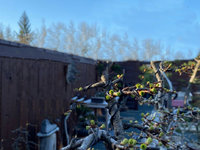Ya know, I hate to be critical, but your upper branches are out of scale and that's bad for a couple reasons. It's a design flaw and it is allowing the apically dominate tree to have too much growth at the crown, which is always going to be at the expense of the lower, lowest, and semi-interior branches. That's not good for another two reasons. The trees don't have any taper now and you are contributing to more of the same. Your only hope to begin to turn that around is to minimize that upper growth in favor of more growth on lower branches, even to excess now, and to be recombobulated back to scale when you get closer to showtime. The upper branches that are thicker than branches below them need to go sooner rather than later. That is part of the positioning process, normally. That choice should have been made before assembly.
View attachment 367630
The upper branches need to be small, close-in, and have little foliage now and for the duration. That will help grow a diminutive, pointy peak for each tree while the bottom is gaining a little, but very little, growth for taper, and the lower branches are developing more massive pads. This is very important because the way we grow our forests, is basically too close, -for artistic reasons, and it causes lost of vitality to the lower sections. Once begun, that process is almost irreversible. The crown and outside edges will also grow as much as we want, and the lower branches are easy to diminish and lose, again for two reasons. The height of the forest means that important rear lower branches will parish over time because they are forever in shade from the mass in front of them and need to be nurtured from day one, and native apical dominance.
I know you know all this and these are the rejects from the workshop, but I thought it was a nice opportunity to list the reasons for doing these things because these pictures are the best teaching aids for other less experienced people. Thanking you in advance for your forbearance.
. Besides working in it, you don’t need to keep the root ball wet with towels or spray bottles.


